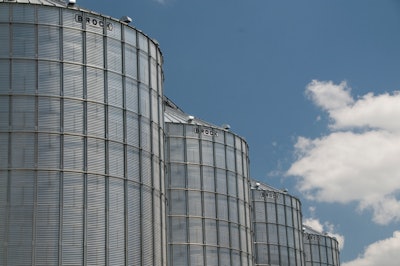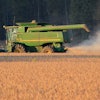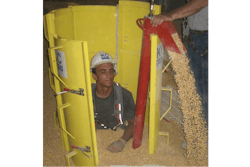
Because of difficult harvest conditions last fall, grain may have been stored with higher than normal moisture content, which could pose a danger to anyone working around the grain.
“高含水量粮食存储导致本unloading problems," warns Ken Hellevang, North Dakota State University Extension agricultural engineer. "Grain may be in clumps due to high-moisture grain and foreign material being frozen together, or due to crusted grain flowing in chunks that block grain flow into the grain sump of the unloading system."
Warming the grain to just above freezing sometimes will enable the frozen grain to flow, he says. People also have used a variety of other methods to break up the clumps, such as a plumbing snake through the unloading tube, high-volume air pressure to the sump through a tube in the unloading tube, or a grain-vac and plumbing snake combination.
"Do not go into the bin without following safety procedures," he cautions.
Grain also can form columns along the bin wall or in other locations. These normally are broken loose with rods or bin unloading whip units from the bin roof. Poking at the grain while inside the bin may cause an avalanche that buries the person poking at the grain.
The grain can flow with such force that it even will come through an open bin door and cover the person poking at the grain from outside the bin.
"Make sure everyone, including family and employees, working around stored grain understands the hazards and proper safety procedures," Hellevang says.
"Too many people ignore safety practices and suffer severe injury or death while working around grain," he adds. "They get trapped in grain or tangled in auger flighting
Grain Bin Dangers
Never enter a bin while unloading grain or to break up a grain bridge or chunks that may plug grain flow. Flowing grain will pull you into the grain mass, burying you within seconds. Unloading at 5,000 bushels per hour is moving almost 2 cubic feet of grain per second. A 2--foot-diameter by 6-foot cylinder has a volume of about 9 cubic feet, so a person can be completely engulfed in less than five seconds and would not be able to lift individual's feet in less than two seconds.
Stop the grain-conveying equipment and use the "lock-out/tag-out" procedures to secure it before entering the bin. Use a key-type padlock to lock the conveyor switch in the "off" position to assure that the equipment does not start automatically or someone does not start it accidentally.
Bridging occurs when grain is high in moisture content, moldy or in poor condition. The kernels stick together and form a crust. A cavity will form under the crust when grain is removed from the bin.
地壳并不足以支持一个人的s weight, so anyone who walks on it will fall into the cavity and be buried under several feet of grain. Determine if the grain has a crust before any grain has been removed. If work needs to be done with a crust, it must be done before any grain is removed.
"To determine if the grain is bridged after unloading has started, look for a funnel shape on the surface of the grain mass," Hellevang advises. "If the grain surface appears undisturbed, the grain has bridged and a cavity has formed under the surface. Stay outside the bin and use a pole or other object to break the bridge loose."
If the grain flow stops when you're removing it from the bin but the grain surface has a funnel shape and shows some evidence that grain has been flowing into the auger, a chunk of spoiled grain probably is blocking the flow. Entering the bin to break up the blockage will expose you to being buried in grain and tangled in the auger.
If grain has formed a vertical wall, try to break it up from the top of the bin with a long pole on a rope or through a door with a long pole. A wall of grain can collapse, or avalanche, without warning, knocking you over and burying you.
Never enter a grain bin alone. Have at least two people at the bin to assist in case of problems. Use a safety harness and rope that prevents you from descending rapidly when entering a bin.
"If you get partially submerged in flowing grain, the force pulling you in is several hundred pounds, far exceeding the ability for a person holding a rope to prevent engulfment," Hellevang says. "Again, never enter a bin with the unloading system running."
Rescuing a Trapped Person
If someone gets trapped:
- Shut off all grain-moving equipment.
- Contact your local emergency rescue service or fire department.
- 如果温度ar通风仓使用风扇e moderate. At cold temperatures, the trapped person faces the risk of hypothermia.
- Cut holes in the bin sides to remove grain if the person is submerged. Use a scoop on a tractor, cutting torch, metal-cutting power saw or air chisel to cut
- V- or U-shaped holes equally spaced around the bin. Grain flowing from just one hole may injure the trapped person and cause the bin to collapse.
- Form a retaining wall around the person using a rescue tube or other material to keep grain from flowing toward the person, then remove grain from around the individual. Walking on the grain pushes more grain onto the trapped person.
- Don't try to pull a person out of grain. The grain exerts tremendous forces, so trying to pull someone out could damage the person's spinal column or cause other damage.
Other Dangers
Getting tangled in the unloading sweep auger is another major hazard. Entanglement typically results in lost feet, hands, arms, legs and frequently death due to the severe damage.
Although you shouldn't enter a bin with an energized sweep auger, it may be necessary in some instances, Hellevang says. All sweep augers should have guards that protect against contact with moving parts at the top and back. The only unguarded portion of the sweep auger should be the front point of operation.
If someone must go into the bin, make sure to have a rescue-trained and equipped observer positioned outside the storage bin. Use a safety switch that will allow the auger to operate only while the worker is in contact with the switch.
Never use your hands or legs to manipulate the sweep auger while it's in operation. The auger should have a bin stop device that prevents the sweep auger from making uncontrolled rotations.
For more information, check out NDSU publication "Caught in the Grain!" It's available online atNDSU-CaughtinGrain.
Source: Ken Hellevang, 701-231-7243,kenneth.hellevang@ndsu.edu
Editor: Ellen Crawford, 701-231-5391,ellen.crawford@ndsu.edu




















